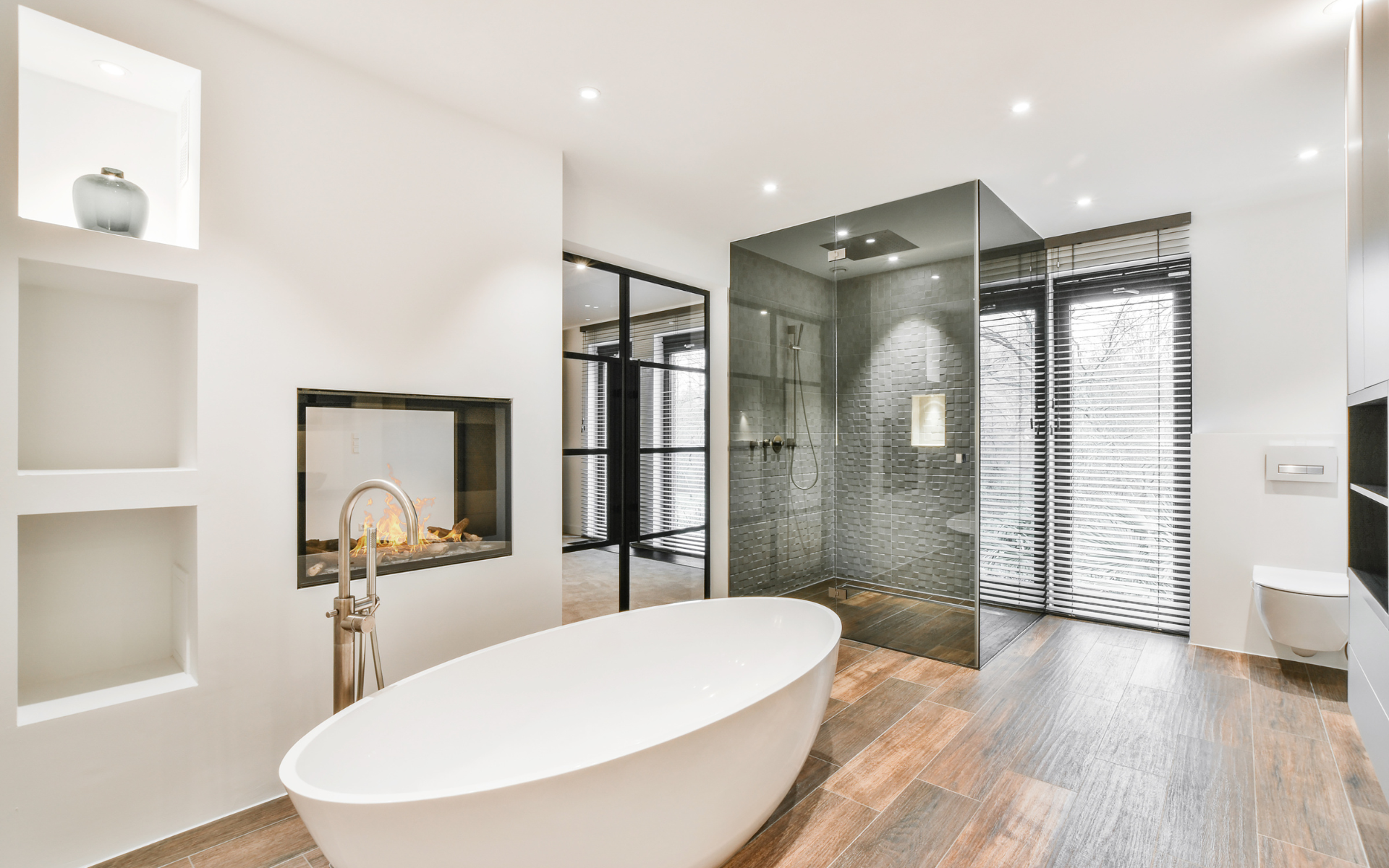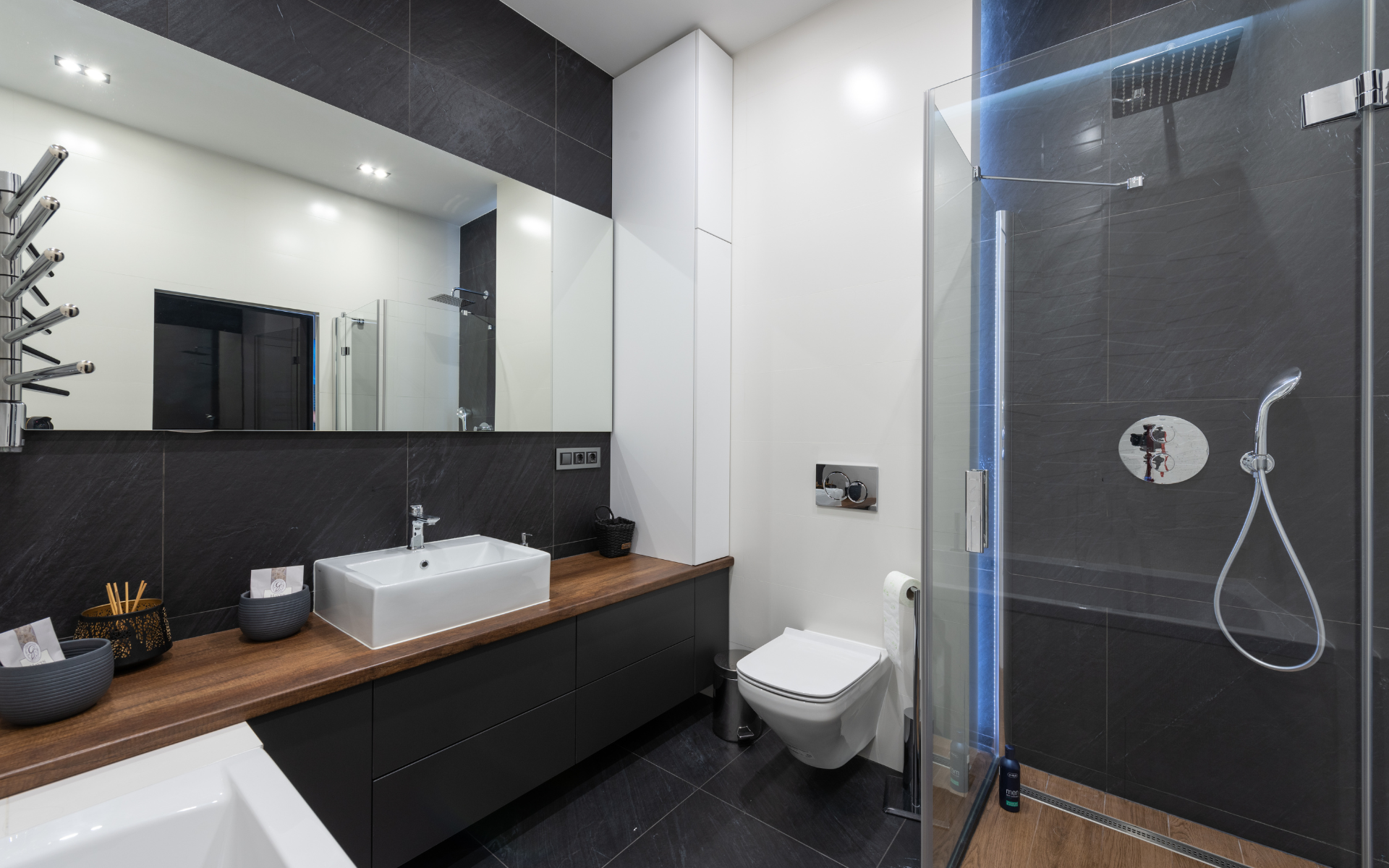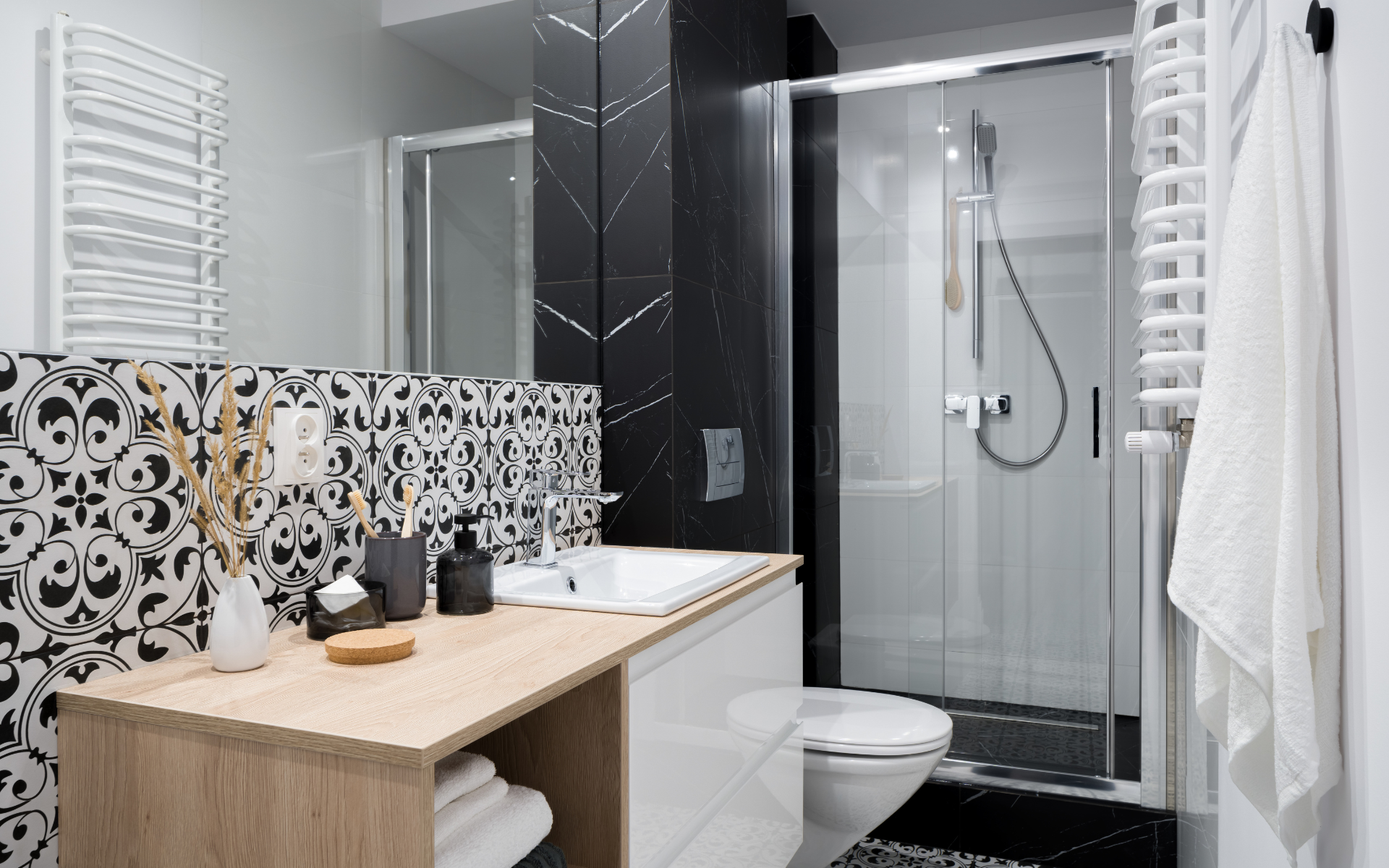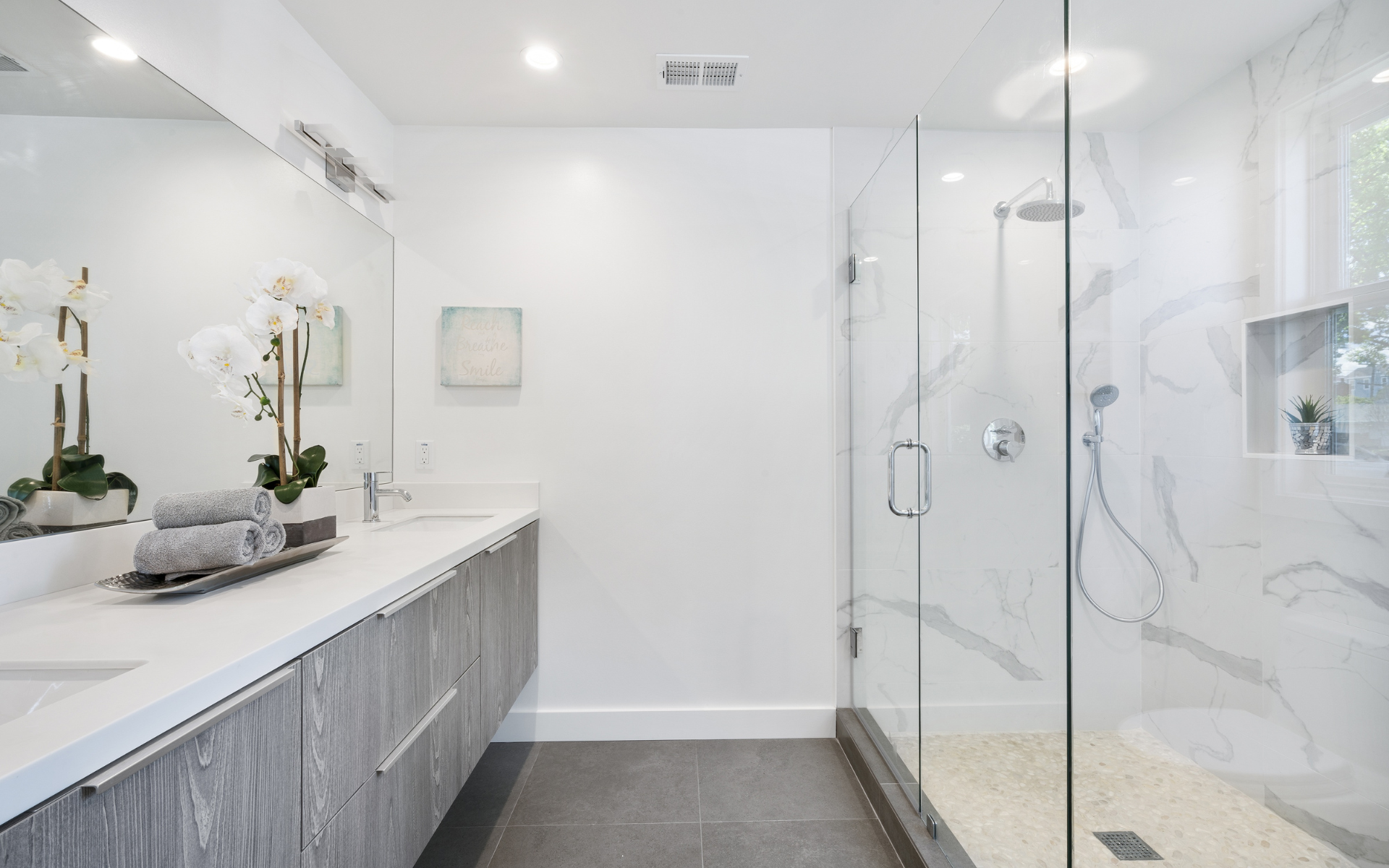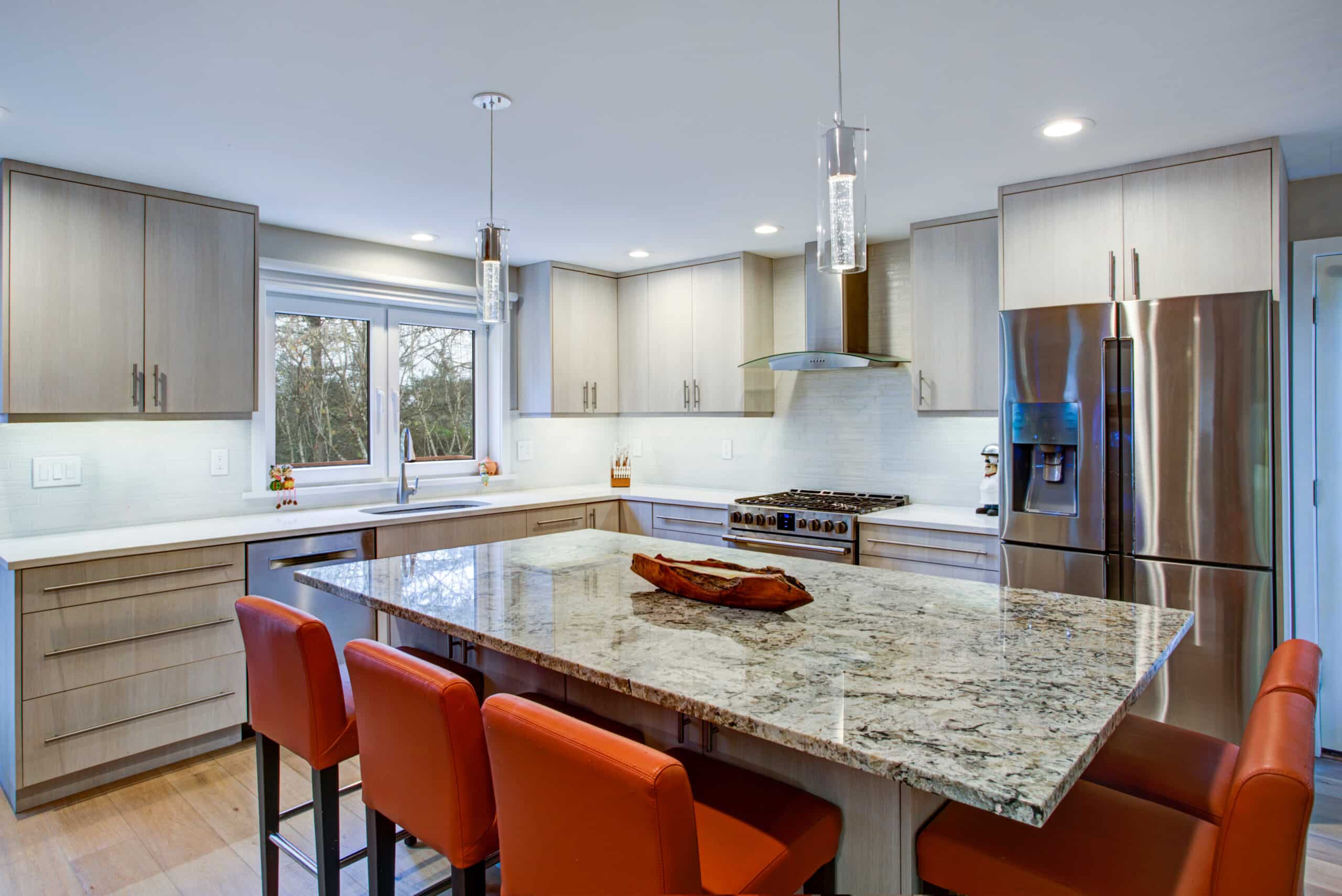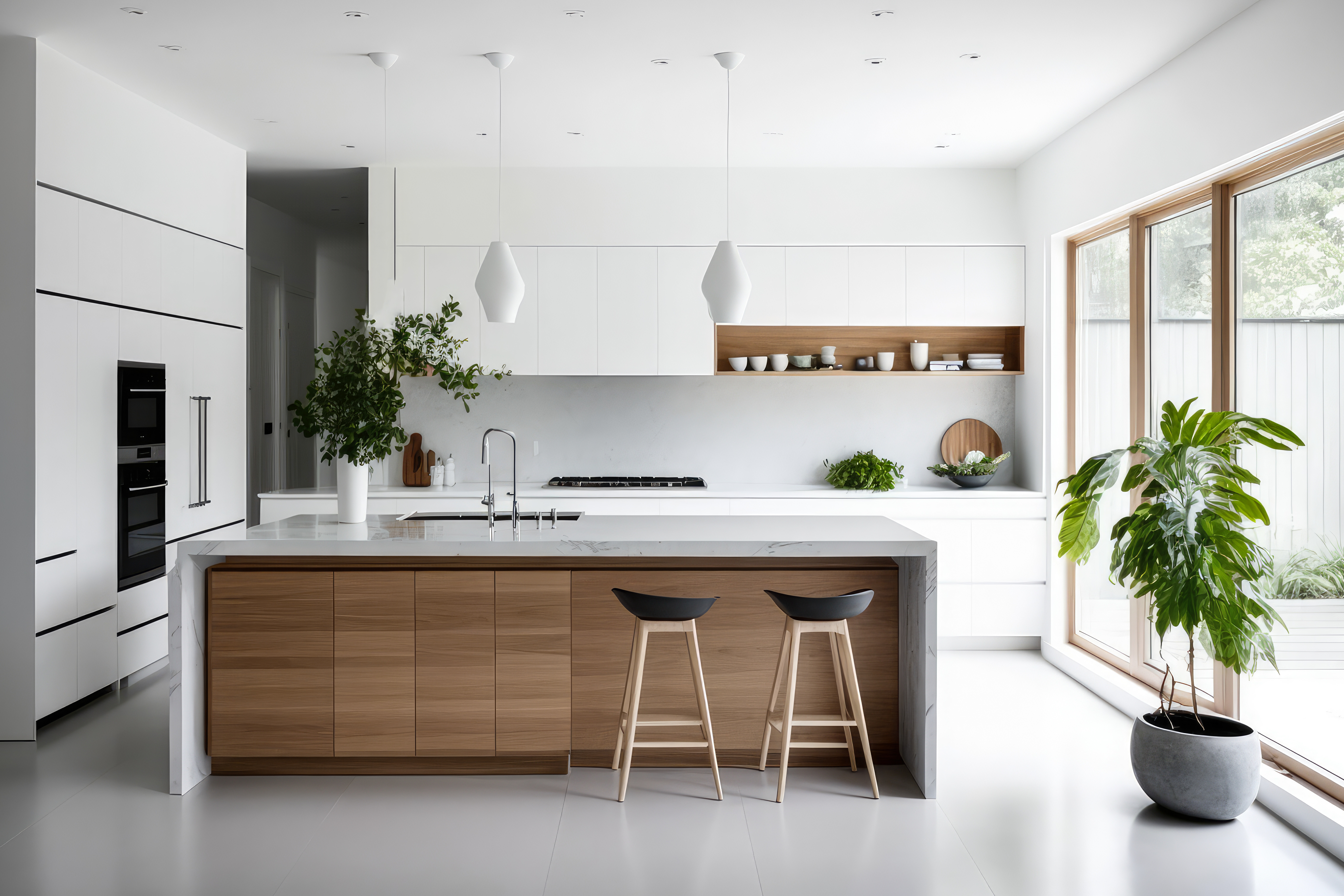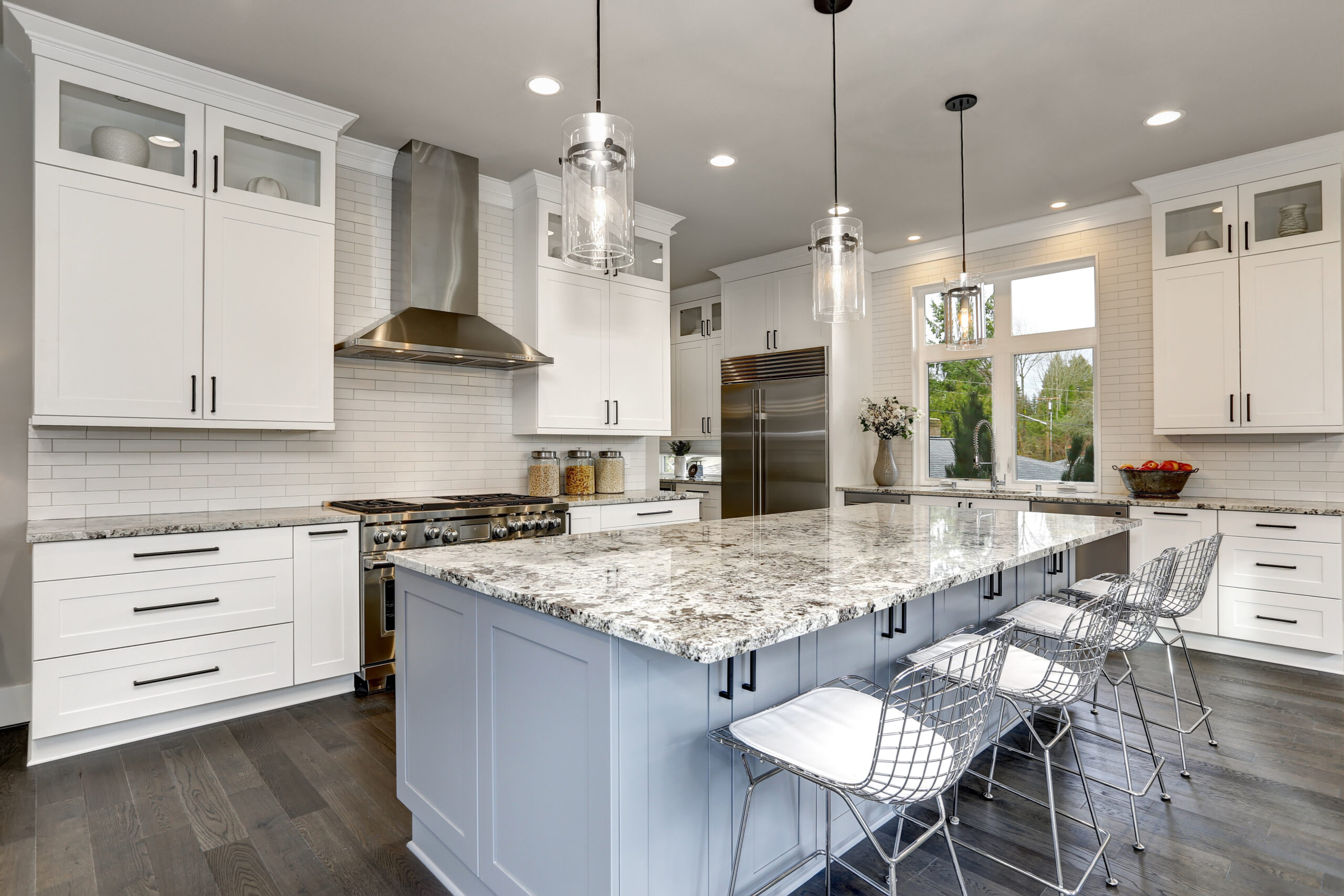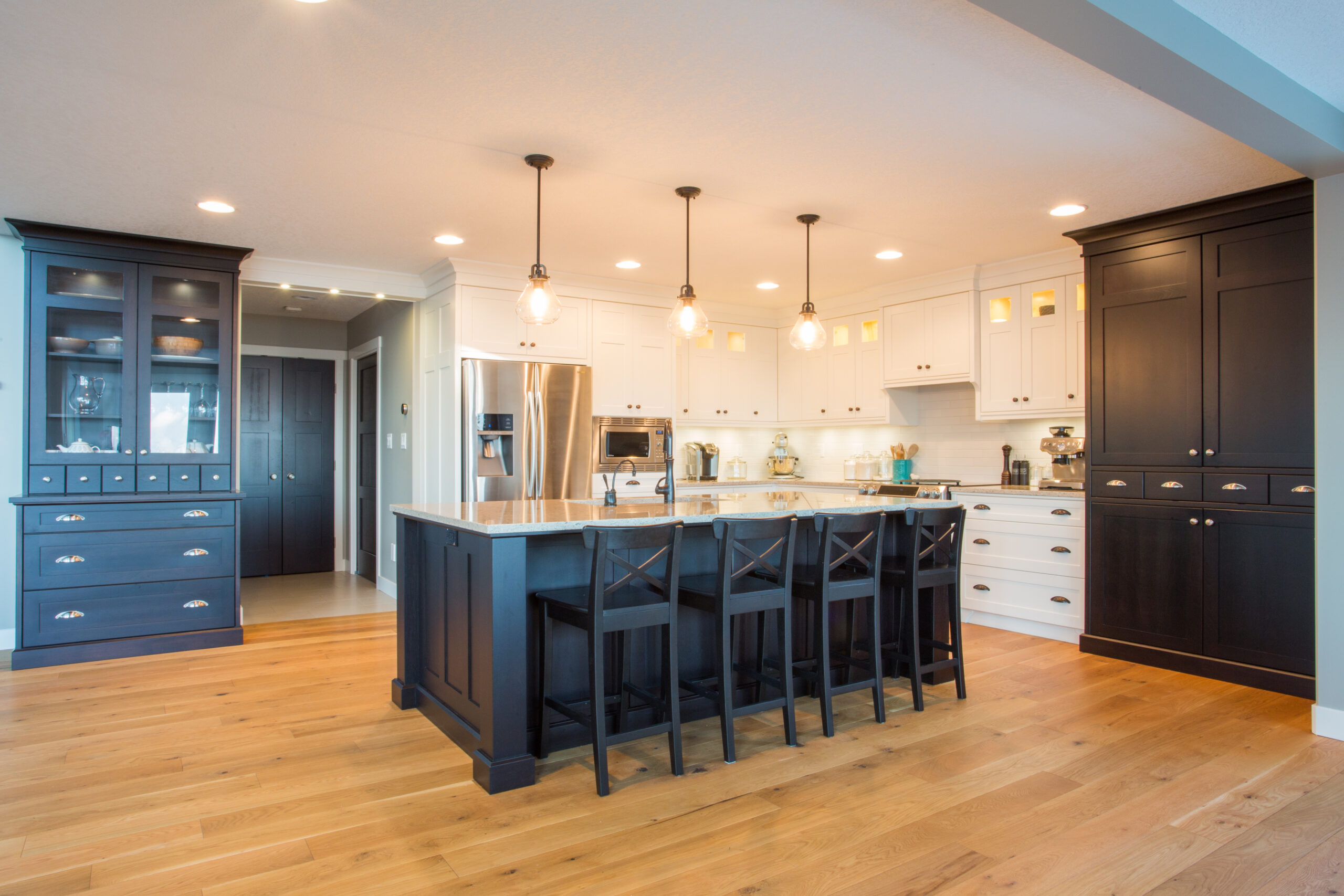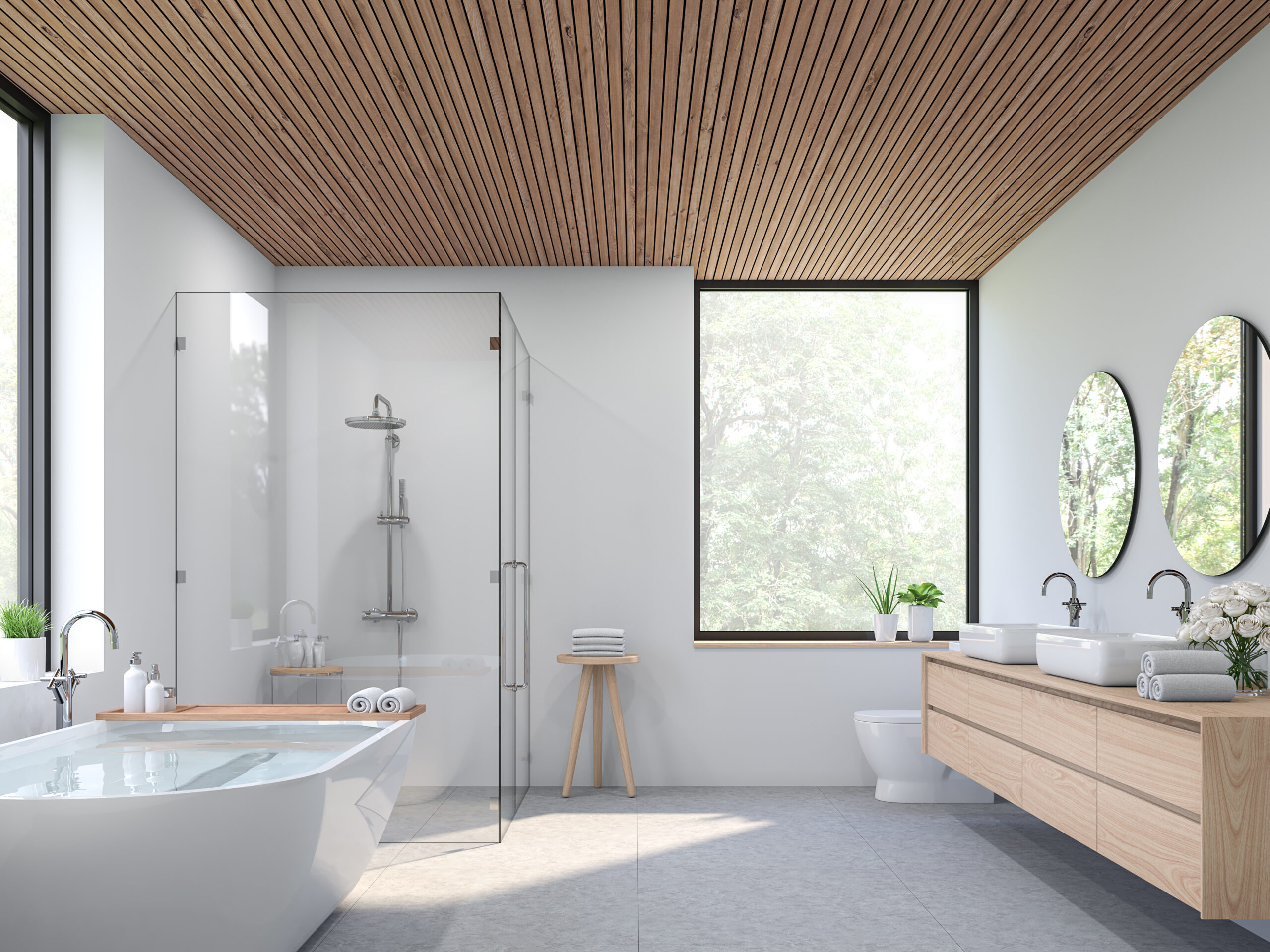Planning a bathroom renovation this year? The average cost of bathroom remodeling is between $6,639 to $17,620. For a master bathroom, it could reach up to $32,000. When it comes to beautifying one’s home, bathroom remodeling is one of the most sought-after options. You can do many things to improve the elegance and function of your bathroom that’ll add value to your home. But if you’re worried about bathroom remodeling cost, this article will be a perfect guide for you.
Your budget for a bathroom remodel depends on many factors. If you’re on a budget, we can help you plan and work on it without going beyond your expected cost of remodeling a bathroom. As a trusted kitchen and bath remodeling company, we understand the importance of creating beautiful, functional spaces within your budget. Without further ado, let’s walk you through our latest guide for bathroom remodel cost.
Understanding Bathroom Renovation Cost
The bathroom remodeling cost varies widely based on several factors. Your renovation costs depend on the project’s complexity, materials selected, and bathroom size. Most homeowners spend between $70 to $250 per square foot for their bathroom project.
Labor costs typically account for 40% to 65% of your overall project cost. This means if you budget $20,000 for your remodeling project, expect to pay $8,000 to $13,000 for professional work. The remaining budget covers materials, plumbing fixtures, and unexpected costs.
Your bathroom size plays a major role in determining the final price tag. A small bathroom measuring 25 square feet costs $1,800 to $6,300, while a 100 square foot space ranges from $7,000 to $25,000. These numbers help establish a starting point for your realistic budget.
Types of Bathroom Remodeling Projects
Different renovation approaches offer varying levels of transformation and investment. Your choice between minor updates, partial renovations, or complete overhauls determines both timeline and total cost. Understanding these options helps you select the approach that best fits your budget and goals.
Full Bathroom Remodel
A full bathroom remodel involves gutting the entire space and starting fresh. This gut remodel typically costs $25,000 to $80,000, depending on materials and square footage. You replace all plumbing fixtures, flooring, walls, and lighting during this major construction project.
The project’s complexity increases when you make layout changes or move plumbing lines. These significant changes require permits and professional expertise, which adds to higher costs. However, a complete renovation delivers the most dramatic transformation and highest resale value.
Mid Range Remodel
A mid-range remodel strikes a balance between cost and quality. These projects cost $10,000 to $25,000 and focus on updating key features without major construction. You might replace the bathroom vanity, install a new shower head, and update light fixtures while keeping the existing layout.
This approach works well for guest bathroom updates or when your current bathroom layout functions well. You get an updated bathroom appearance without the expense of moving plumbing or electrical systems.
Minor Bathroom Updates
Minor updates cost $3,000 to $10,000 and focus on cosmetic improvements. These projects include painting, replacing towel racks, installing new mirrors, and updating hardware. While the cost range seems lower, these changes still make a significant impact on your bathroom’s appearance.
This option works best when your plumbing fixtures function well but need a fresh look. You cut costs while achieving a noticeable improvement in your space.
Bathroom Types and Their Costs
Each bathroom type in your home serves different purposes and requires different investment levels. The size, usage patterns, and expectations for each space influence material choices and renovation costs. Here’s how costs break down for different bathroom types.
Primary Bathroom Renovation
Master bathrooms typically require the largest investment due to their size and luxury expectations. The average primary bathroom measures 120 square feet and costs $8,400 to $30,000 to renovate. These spaces often feature dual sinks, a walk-in shower, and premium materials.
Homeowners frequently choose high-end materials for their primary bathroom since they use this space daily. Natural stone countertops, custom cabinetry, and spa-like features add comfort and value. The total cost reflects both the larger square footage and quality expectations.
When planning your primary bathroom, consider energy efficiency features like installing low flow toilets and LED lighting. These upgrades reduce long-term operating costs while supporting environmental goals.
Guest Bathroom Projects
A guest bathroom renovation costs $5,600 to $20,000 for a standard 80 square foot space. These bathrooms need durability and style without the luxury features of master bathrooms. Focus on quality basics that create a welcoming space for visitors.
Stock vanities and standard plumbing fixtures keep costs reasonable while providing good functionality. Choose neutral colors and timeless designs that appeal to various users. This approach ensures your guest bathroom remains attractive without frequent updates.
Small Bathroom Remodeling
Small bathroom renovations present unique challenges and opportunities. The average cost is $6,500, but projects range from $1,500 to $15,000 depending on scope and materials. The limited square footage means higher costs per square foot due to fixed installation expenses.
Space planning becomes critical in small bathrooms. Every inch matters, so choose compact fixtures and smart storage solutions. A well-designed small bathroom feels larger and functions better than poorly planned larger spaces.
Consider a shower instead of keeping an existing tub to maximize space. This change opens up the room and creates a more modern feel without major plumbing modifications.
Powder Rooms
Powder rooms offer the most affordable renovation option, costing $1,500 to $15,000 for about 30 square feet. These half-baths include only a toilet and sink, making material and labor requirements minimal.
Despite their small size, powder rooms allow for bold design choices since guests use them briefly. You might splurge on statement wallpaper or a luxury faucet that would be impractical in larger spaces. The final cost remains manageable due to the limited square footage.
Breaking Down Major Components
Understanding individual component costs helps you allocate your budget effectively and make informed decisions about where to spend and where to save. Each element contributes differently to both function and overall project cost. Let’s examine the major categories that make up your bathroom renovation.
Plumbing Fixtures and Installation
Installing a new toilet averages $375 for a standard model. Low-flow toilets cost slightly more upfront but save water and money over time. Smart toilets with advanced features can cost $2,000 to $13,000, dramatically affecting your overall cost.
The existing plumbing usually accommodates a new toilet without major modifications. However, moving the toilet location requires new plumbing lines and increases labor costs significantly.
Shower installation averages $8,200, but costs range from $300 to $15,000 based on complexity. A basic shower kit costs much less than a custom walk-in shower with natural stone walls.
Replacing an existing tub with a new tub costs $2,000 to $9,400. The material choice affects price considerably. Basic acrylic tubs cost less than cultured marble or natural stone options. Removing an old tub and installing something different adds to labor costs.
Converting your existing tub to a walk-in shower costs $1,200 to $3,600. This popular update works well in primary bathrooms where safety and accessibility matter more than soaking options.
Your bathroom vanity serves as both storage and a design focal point. Stock vanities cost $100 to $2,600, while custom cabinetry ranges from $1,000 to $4,000 or more. The choice between pre-made and custom options significantly impacts your total project cost.
Consider your storage needs when selecting vanity size and configuration. Dual sinks work well in master bathrooms but may overwhelm smaller spaces. A single vanity with ample storage often provides better value in guest bathrooms.
Flooring and Surface Materials
Bathroom flooring must withstand moisture while providing safety and style. Material costs vary depending on your selection and quality level. Installation requirements also affect the final cost of your flooring project.
Material costs vary considerably:
- Vinyl: $1-$14 per square foot
- Ceramic tile: $2-$30 per square foot
- Porcelain: $2-$30 per square foot
- Natural stone: $5-$35 per square foot
Installation adds $3-$7 per square foot to material costs. Complex patterns or small tiles increase labor time and costs. Choose materials that balance your budget with durability needs.
Wall Treatments
Shower walls require waterproof materials to prevent damage. Tile remains the most popular choice, with ceramic offering affordability and natural stone providing luxury appeal. Wall tile installation costs $10-$50 per square foot, including labor.
Paint works well for non-shower areas and costs much less than tile. Quality bathroom paint resists moisture and mildew, making it practical for powder rooms and areas away from direct water exposure.
Countertop Materials
Countertop selection affects both function and appearance. Your choice impacts daily use, maintenance requirements, and overall bathroom design. Premium materials offer better durability but require larger budget allocation.
Material options include:
- Laminate: $8-$27 per square foot
- Ceramic: $1-$15 per square foot
- Granite: $15-$140 per square foot
- Marble: $15-$190 per square foot
- Quartz: $20-$75 per square foot
Premium materials cost more but offer better durability and resale value. Balance your budget with expected usage and style preferences when selecting countertop materials.
Labor Costs and Professional Services
Professional services represent a major portion of your bathroom renovation investment. Understanding different professional roles and their costs helps you budget appropriately and select the right team for your project. Quality professionals ensure code compliance, proper installation, and long-lasting results.
General Contractors
General contractors coordinate your entire bathroom project and typically charge 10% to 20% of the total project cost. They manage permits, schedule trades, and ensure work meets building codes. This coordination saves you time and reduces stress during renovation.
Experienced contractors understand local requirements and common challenges. They help avoid costly mistakes that DIY projects sometimes encounter. The investment in professional management often pays for itself through efficient scheduling and quality workmanship.
Plumbing Professionals
Plumbers charge $45 to $200 per hour depending on location and complexity. Simple fixture replacements cost less than major pipe relocations. Moving plumbing lines for layout changes requires significant expertise and adds substantially to labor costs.
Always hire licensed plumbers for water supply and drain connections. Improper plumbing work leads to expensive water damage that far exceeds any savings from DIY attempts.
Electrical Work
Electricians charge $50 to $200 per hour for bathroom work. Updating lighting, adding outlets, and installing ventilation fans requires electrical expertise. Bathroom electrical work must meet strict safety codes due to moisture concerns.
Modern bathrooms often need additional electrical capacity for features like heated floors, smart mirrors, and high-powered ventilation fans. Factor these upgrades into your budget if desired.
Interior Designer Services
Interior designers charge $50 to $200 per hour or $5 to $15 per square foot. Professional design help ensures efficient space use and cohesive material selection. This investment pays off in better functionality and visual appeal.
Designers understand current trends while helping you avoid costly mistakes. They also have access to trade-only products that might not be available to consumers directly.
Planning Your Bathroom Layout
Effective layout planning maximizes your bathroom’s functionality while controlling renovation costs. Smart design decisions improve daily use and prevent expensive changes later. Consider both current needs and future requirements when planning your new bathroom space.
Space Optimization
Effective bathroom design maximizes function within available space. Keep existing plumbing locations when possible to control costs. Moving fixtures requires new supply lines and drains, significantly increasing renovation costs.
Consider traffic flow when planning your new bathroom layout. Adequate clearance around fixtures ensures comfortable daily use. Standard clearances include 15 inches from centerline to walls for toilets and 30 inches in front of all fixtures.
Storage planning often gets overlooked during renovation excitement. Include adequate storage for towels, toiletries, and cleaning supplies. Built-in storage costs more initially but provides better long-term value than aftermarket additions.
Accessibility Considerations
Plan for future accessibility needs, especially in primary bathrooms. Features like grab bars, curbless showers, and comfort-height toilets add minimal cost during renovation but would be expensive to retrofit later.
These universal design principles benefit users of all ages and abilities. They also appeal to potential buyers if you sell your home, making them smart investments beyond personal convenience.
Managing Your Budget
Successful budget management prevents cost overruns and financial stress during your bathroom project. Smart planning and realistic expectations help you achieve your renovation goals within your financial means. Understanding cost factors enables better decision-making throughout the project.
Setting a Realistic Budget
Start budget planning by determining your available funds, including both cash and financing options. Add 15-20% contingency for unexpected costs that commonly arise during bathroom projects. This buffer prevents mid-project financial stress when surprises occur.
Research costs in your area since labor and material prices vary considerably by location. Urban areas typically cost more than rural locations, but material availability might be better.
Get detailed quotes from multiple contractors to understand local market rates. Compare line items carefully since some contractors include items that others list separately.
Cost-Saving Strategies
Choose materials strategically to balance cost and quality. Splurge on items you touch daily like faucets and towel racks. Save money on hidden elements like subfloor materials and interior vanity construction.
Mix price points thoughtfully. Combine one premium element with standard-quality supporting materials. For example, choose luxury floor tile with standard wall paint rather than premium everything.
Schedule projects during contractors’ slower seasons to potentially negotiate better rates. Winter months often offer more flexibility and competitive pricing than busy spring and summer periods.
Handle appropriate tasks yourself while leaving technical work to professionals. Painting, installing accessories, and basic cleanup save money without risking quality or safety.
Prepare the space before contractors arrive by removing personal items and old accessories. This preparation reduces billable hours and helps projects start smoothly.
Unexpected Bathroom Remodeling Cost and Expenses
Bathroom renovations often reveal hidden issues that weren’t apparent during initial planning. Preparing for these potential costs prevents budget surprises and project delays. Understanding common unexpected expenses helps you plan more accurately.
Permits and Inspections
Most bathroom renovations require permits, especially when modifying plumbing or electrical systems. Permit costs range from $100 to $1,000, depending on project scope and local requirements. Your contractor typically handles permit applications and scheduling inspections.
Building codes change periodically, and older homes might need updates to meet current standards. These code compliance costs aren’t always obvious during initial planning but become necessary once work begins.
Structural Issues
Removing old fixtures sometimes reveals hidden problems like water damage, outdated wiring, or structural issues. Addressing these problems adds unexpected costs but prevents future complications.
Budget extra money for potential surprises, especially in older homes. Common issues include rotted subfloors, outdated plumbing connections, and inadequate electrical capacity for modern fixtures.
Disposal and Cleanup
Demolition creates substantial debris that requires proper disposal. Disposal costs range from $100 to $800, depending on project size and local dump fees. Some contractors include disposal in their quotes while others charge separately.
Factor in cleanup time and materials for dust control and protecting other areas of your home. Professional contractors typically handle final cleanup, but ongoing maintenance during construction often falls to homeowners.
Maximizing Return on Investment
Smart renovation choices provide better long-term value and enjoyment from your bathroom investment. Focus on improvements that enhance both daily use and potential resale appeal. Understanding which upgrades provide the best returns helps guide your spending decisions.
Focus on Key Upgrades
Prioritize improvements that provide the best returns:
- Updated fixtures – immediate visual impact without major construction
- Improved lighting – enhances function and atmosphere
- Fresh finishes – appeals to buyers and daily users
- Fix functional problems first – leaks, ventilation, and storage issues
- Address safety concerns before focusing on decorative elements
Functional improvements provide better long-term value than purely aesthetic changes.
Quality Where It Matters
Invest in quality for frequently used items like faucets, shower heads, and flooring. These elements affect daily experience and durability. Choose standard quality for items like paint and basic hardware that are easily updated later.
Premium materials in highly visible areas create luxury impressions without premium costs throughout the entire space. Strategic splurging delivers maximum impact within budget constraints.
Timeless Design Choices
Avoid overly trendy elements that might look dated quickly. Classic materials and neutral colors provide longer-lasting appeal and broader market acceptance. Add personality through easily changed elements like accessories and paint colors.
Well-designed bathrooms remain attractive for 10-15 years before needing major updates. Planning for longevity reduces long-term ownership costs and provides better enjoyment during daily use.
Working with Professionals
Selecting the right professional team ensures quality results and smooth project execution. Understanding different professional roles and what to expect helps you make informed hiring decisions. Quality professionals prevent costly mistakes and deliver lasting results.
Choosing the Right Team
Select contractors using these criteria:
- Experience and references – verify past work quality
- Licenses and insurance – ensure proper credentials
- Communication style – clear, responsive interaction
- Detailed contracts – clear timelines and scope
- Local references – check recent project reviews
Quality workmanship prevents costly repairs and ensures project completion on schedule. Avoid choosing based on lowest price alone.
Project Management
Successful bathroom renovations require careful coordination of multiple trades and deliveries. Professional contractors manage these details, but homeowners should understand the general timeline and major milestones.
Plan for temporary bathroom arrangements during construction. Full bathroom remodels typically take 3-8 weeks, during which the space remains unusable. Coordinate with family members and consider timing around travel or other disruptions.
Final Thoughts
Bathroom remodeling cost varies significantly based on your goals, space, and material choices. Understanding these factors helps you make informed decisions that balance budget constraints with desired outcomes. Professional guidance ensures efficient use of renovation dollars while avoiding costly mistakes. Quality planning and execution create bathrooms that provide years of enjoyment and strong resale value.
We provide comprehensive services from initial design through final installation. Our expertise in space planning, material selection, and project management ensures smooth execution and outstanding results. Our showroom features current products and materials, helping you make informed choices for your project. We work with trusted suppliers to provide quality materials at competitive prices.
Ready to start your bathroom renovation? Contact Mudosi Kitchen and Bath or visit our showroom at Parsippany, NJ. Schedule your free consultation today and discover how we can transform your bathroom while respecting your budget and timeline.

